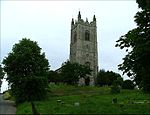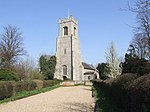Mendham, Suffolk

Mendham is a village and civil parish in the Mid Suffolk district of Suffolk in eastern England. Located on the east bank of the River Waveney around a mile east of Harleston, the parish includes the hamlets of Withersdale Street. The Mendham Marshes are also within the parish boundaries. All Saints Church is a medieval church, Grade I listed, that was restored in the 1860s. It is now one of six churches in the Sancroft Benefice. The village of Mendham came under Mendham Priory until the dissolution of the monasteries. Mendham Priory then became a private house. The present house is an early 19th century neo-classical mansion, with a Doric style porch, built for Alexander Adair. The Priory was later the home of the Dimmock family.Until the 19th century, around 25% of the parish fell in Norfolk and 75% in Suffolk.Mendham's most famous son, born to a local miller, was Sir Alfred James Munnings KCVO, PRA (8 October 1878 – 17 July 1959), known as one of England's finest painters of horses, and as an outspoken enemy of Modernism. An extract of one of his paintings, featuring gypsy Charlotte Gray leading a pony, has been incorporated into the Mendham village sign. Her husband Frederick or 'Nobby' Gray was one of Alfred's closest friends and a model in some of his paintings. Both Nobby and Charlotte are buried in All Saints churchyard in Mendham. Two-time world champion darts player Peter Wright also lives in Mendham.
Excerpt from the Wikipedia article Mendham, Suffolk (License: CC BY-SA 3.0, Authors, Images).Mendham, Suffolk
Withersdale Road, Mid Suffolk
Geographical coordinates (GPS) Address Nearby Places Show on map
Geographical coordinates (GPS)
| Latitude | Longitude |
|---|---|
| N 52.397669 ° | E 1.337629 ° |
Address
Withersdale Road
Withersdale Road
IP20 0NJ Mid Suffolk
England, United Kingdom
Open on Google Maps








